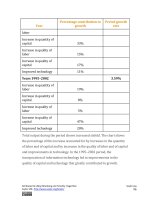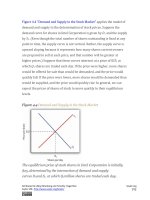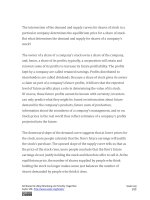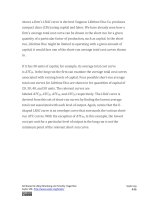Authors libby rittenberg 467
Bạn đang xem bản rút gọn của tài liệu. Xem và tải ngay bản đầy đủ của tài liệu tại đây (524.92 KB, 1 trang )
bushel of, say, hard winter wheat is an example. A bushel produced by one
farmer is identical to that produced by another. There are no brand
preferences or consumer loyalties.
The assumption that goods are identical is necessary if firms are to be
price takers. If one farmer’s wheat were perceived as having special
properties that distinguished it from other wheat, then that farmer would
have some power over its price. By assuming that all goods and services
produced by firms in a perfectly competitive market are identical, we
establish a necessary condition for price-taking behavior. Economists
sometimes say that the goods or services in a perfectly competitive market
are homogeneous, meaning that they are all alike. There are no brand
differences in a perfectly competitive market.
A Large Number of Buyers and Sellers
How many buyers and sellers are in our market? The answer rests on our
presumption of price-taking behavior. There are so many buyers and
sellers that none of them has any influence on the market price regardless
of how much any of them purchases or sells. A firm in a perfectly
competitive market can react to prices, but cannot affect the prices it pays
for the factors of production or the prices it receives for its output.
Ease of Entry and Exit
The assumption that it is easy for other firms to enter a perfectly
competitive market implies an even greater degree of competition. Firms
in a market must deal not only with the large number of competing firms
but also with the possibility that still more firms might enter the market.
Attributed to Libby Rittenberg and Timothy Tregarthen
Saylor URL: />
Saylor.org
467









